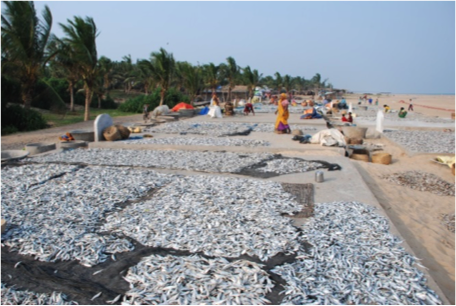Dry fish platforms constructed under MGNREGS have become a great source of permanent income for the poor fishing community in Rameyapatna village under Chikkiti block of Ganjam district situated close to the coast of Bay of Bengal. Engaging in dry fish trade is popular amongst the fishing community here, as there is a big demand for traditional fish products that ensures livelihood and food security during lean seasons.
IMPLEMENTATION

In 2014-15, seven dry fish yards were sanctioned in Rameyapatna village at an estimated cost of Rs 75,000 each to cater to 600 beneficiaries. The size of the yard was 26X22 in length and breath.
Construction of dry fish yard platforms was the first of its kind project taken up under MGNREGS with the objective of supporting the fishing community by preserving the surplus fish that remained unsold in the market. During the glut period, they set aside a good volume of fresh catch to be converted into dry fish. The fish drying process starts early in the morning. The use of the platform is determined on a first come basis to avoid any confusion within the community. The advantage of drying fish on the platform is that approximately 1000 kg of fish can be dried in a heap on the platform, whereas 500 kg can be dried in an individual mode on the platform. As there is a strong preference in the market for sand free fish, the fish drying yards under MGNREGS have been constructed to suit this local requirement.
IMPACT

A majority of people involved in traditional small-scale fish drying are women and the dry yard under MGNREGS has cast multi-dimensional impact upon the fishing community. It creates a variety of work opportunities for women such as carrying fish from the seashore to the village, drying the fish, taking the fish out of the big pot where it is kept in salty water for some days etc. Before the platform was constructed, it used to take three days to dry the fish, but now it takes maximum two day or even one day when the sun is strong and can dry 500-1000 kg at one go. Depending on the kind of fish, the community can increase profits by selling a huge quantity of fish to the traders. The sand dried fish fetched lesser price as can be seen in the table compared to platform dried fish. With the dry yard, the quality of the dry fish has also gone up substantially as has the demand. The fish which was earlier sold at Rs 100 to Rs 130 per kg is now sold at Rs 180 to 200 per kg.
The table below shows the variation in cost of fish drying on the platform and on sand:
| Type of fish | Catch of fish (per month) | Price when dried on sand | Price after drying on platform |
| Small | |||
| Kukuli | 600 – 700 kg | 50 per kg | 100-120 per kg |
| Kabala | 1200 kg | 30 per kg | 50 per kg |
| Kanaburda | 2000 – 3000 kg | 20 per kg | 50 per kg |
| Patia | 1000 kg | 100 per kg | 150 – 200 per kg |
| Kara | 2000 kg | Rs 20 per kg | Rs.40 per Kg |
VOICES FROM THE FIELD
“According to a rough estimate every day we earn approximately Rs 1500-2000 as profit from the platform dried fish. During peak period, this results in a monthly income of Rs. 40000 – 50000”- K Sabitri, a fisherwoman who heads a self-help group in the village when she was asked how the dry fish yard changed her life and income.
“Now, we are saved from distress sale of fish. During peak season, we prefer to dry fish instead of distress sale,” – B. Chendramma, a beneficiary.
“Some fishermen here have taken up marketing of dried fish for human consumption in a big way. Attractive and hygienic vacuum packaging of the products practiced by some people has helped in increasing the market share of dried fish. About 400 labourers are directly or indirectly employed in fish drying and associated work in the village,” – B.Devamma, a beneficiary.
“Due to the construction of fish yard platform, we are able to earn money to educate our children and provide for their necessities”- B. Umapati, a beneficiary.

Leave a comment